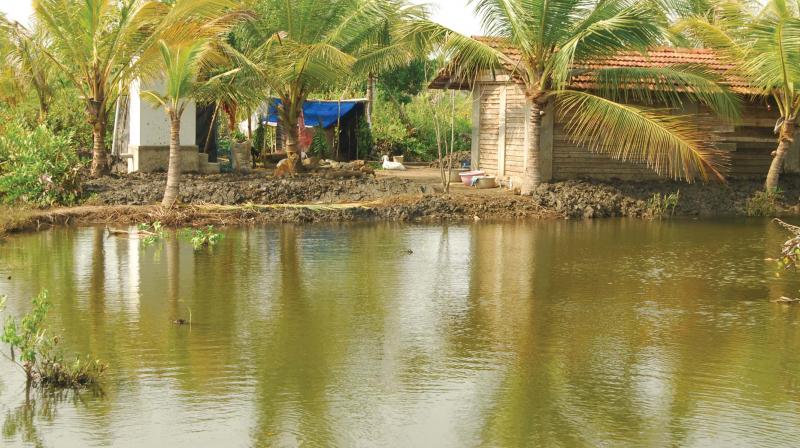When an island sinks
There have been reports that at least 200 families have fled the land. Some of the residents swear it is untrue, while others seem vague.

Scientists have several theories including global warming to explain why Munroe Thuruth is sinking. But its residents, nowhere to go, have other doubts, too. There are man-made local reasons behind the phenomenon, they believe. A journey through the unlikely island off Kollam.
Hanging on a tree, in big legible letters is the name Soman and what’s clearly a phone number, beneath it. Seeing what appeared to be two tourists stopping in front of the Ashtamudi Lake, Soman comes running to offer his services. And yes, there’s his boat close by, waiting to be rowed across the lake, to get the owner a day’s worth.
Here is where the Kallada River ends and the Ashtamudi Lake begins. But these visitors are not tourists. They ask Soman about the recent stories of the land – of Munroe Thuruthu, the beautiful island in Kollam district, sinking by the day and its residents fleeing.
Soman and Prabhakaran, a curious passerby stopping by, say that is not the real problem. The problem began when the floods stopped happening after the Kallada dam got built, they say, because that stopped the silt from getting deposited on the shores, stopped the growth of their trees and hurt their farms. All that the scientists had been saying about the island sinking, say Soman and Prabhakaran, are pure rot.
The scientists that they talk about have come from various corners. V.K. Madhusoodanan of the Kerala Sasthra Sahitya Parishad had submitted a report citing 22 reasons, 40 to 50 per cent of it related to climate change, to the government. Environmental scientist Sainudeen Pattazhy, has, however vehemently opposed the cause of global warming and blame the submersion on the impact from the Tsunami of December, 2006. Teams from colleges – the TKM, the CUSAT, have also done studies. But the residents of Munroe Thuruthu would tell you, none of those studies, none of those many media reports, or authorities visiting, have helped them in any way.
A woman sitting sipping black coffee on the steps of her neighbour’s house plead with us to not write another story on the sorry state of the island. “You people come here, take our photos, and write this land is going to drown.
People read it and then stop buying our lands. The value has gone down so much. And none of the governments have given us any money or thought of giving us one grain of sand,” she says.
There have been reports that at least 200 families have fled the land. Some of the residents swear it is untrue, while others seem vague. “It is not the whole of the island that’s affected, but more towards the Peringanoor ward,” says Vijayan, who has been running a small hotel in the island for over 20 years. “You can see the foundation going lower, as the water rises.”
You need to cross a railway line to reach this other side. And as you do, you spot the friendliness that small towns are famous for. They all want to help you, offering chairs to sit and evening tea to complete strangers who have come asking stories of the island. “Every evening, the water would rise and come into our houses. We just sit inside and hope it goes away. Where can we go?” asks Rajeev, having coffee with his friend Prasad, both doing pipe works for a living. They show the newly laid path in front, without which children walked to the school uphill, dipping themselves in the water from floods.
“It is only people with money that go away. They have houses in the city to move. It is the poor that suffer,” says Shiny, whose family is into pearl spot (karimeen) farming. The road in front of their house had come only in February. Till then they’d wade through the water.
Professor Sainudeen, who has been studying the island independently for three years now, says the whole theory that it is the effect of global warming started when a former MP had said so in the Rajya Sabha, and wouldn’t admit he’s wrong. “If it was a global warming impact, it wouldn’t be confined to one place. Different parts of Ashtamudi Lake would have risen. But only one area – Munroe Thuruthu – has been affected. There are high tides happening very often in the island, but it is not there in other parts of the lake,” he says. “Many areas in the Alappuzha-Kollam-Thiruvananthapuram region have changed, because of post-Tsunamic impact. It will take years (for the impact to be over).”
The solution, he says, is to take precautionary measures, declare the island a national disaster area, rehabilitate affected families, provide soil facilities for agriculture, promote village tourism, and so on.
None of these, however, seem to have stopped tourists from visiting. You can spot the odd tourist on a boat, or on the roads, taking in all the beauty of the island that’s all green and water and ducks swimming.

